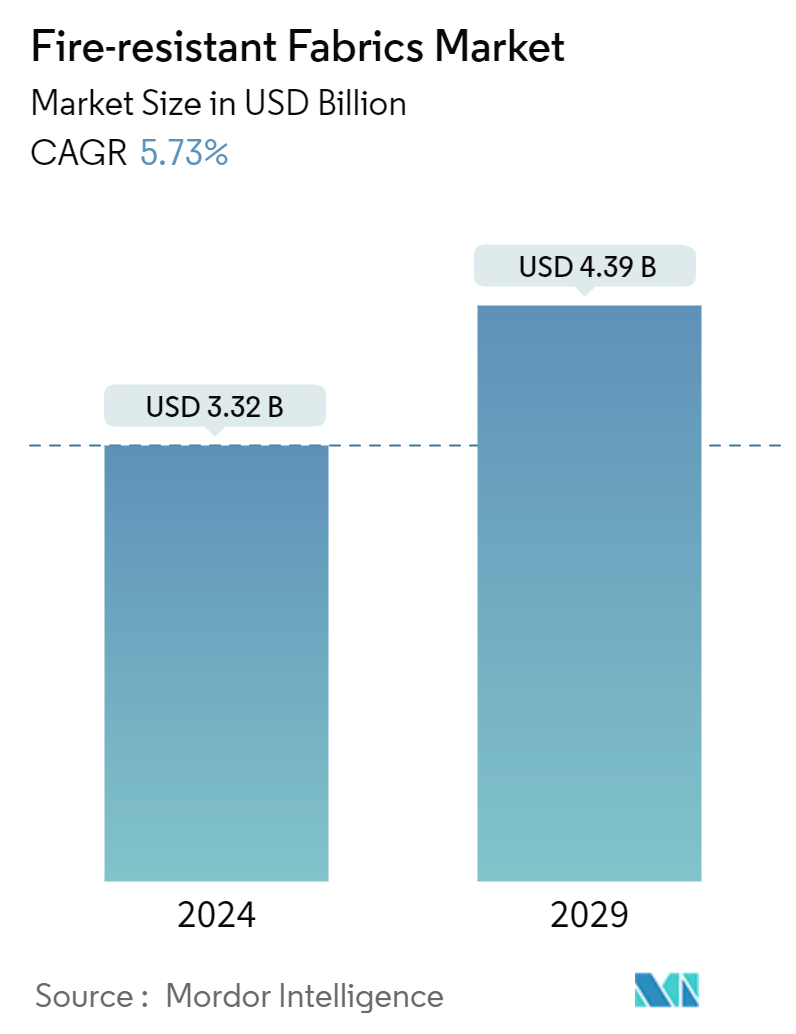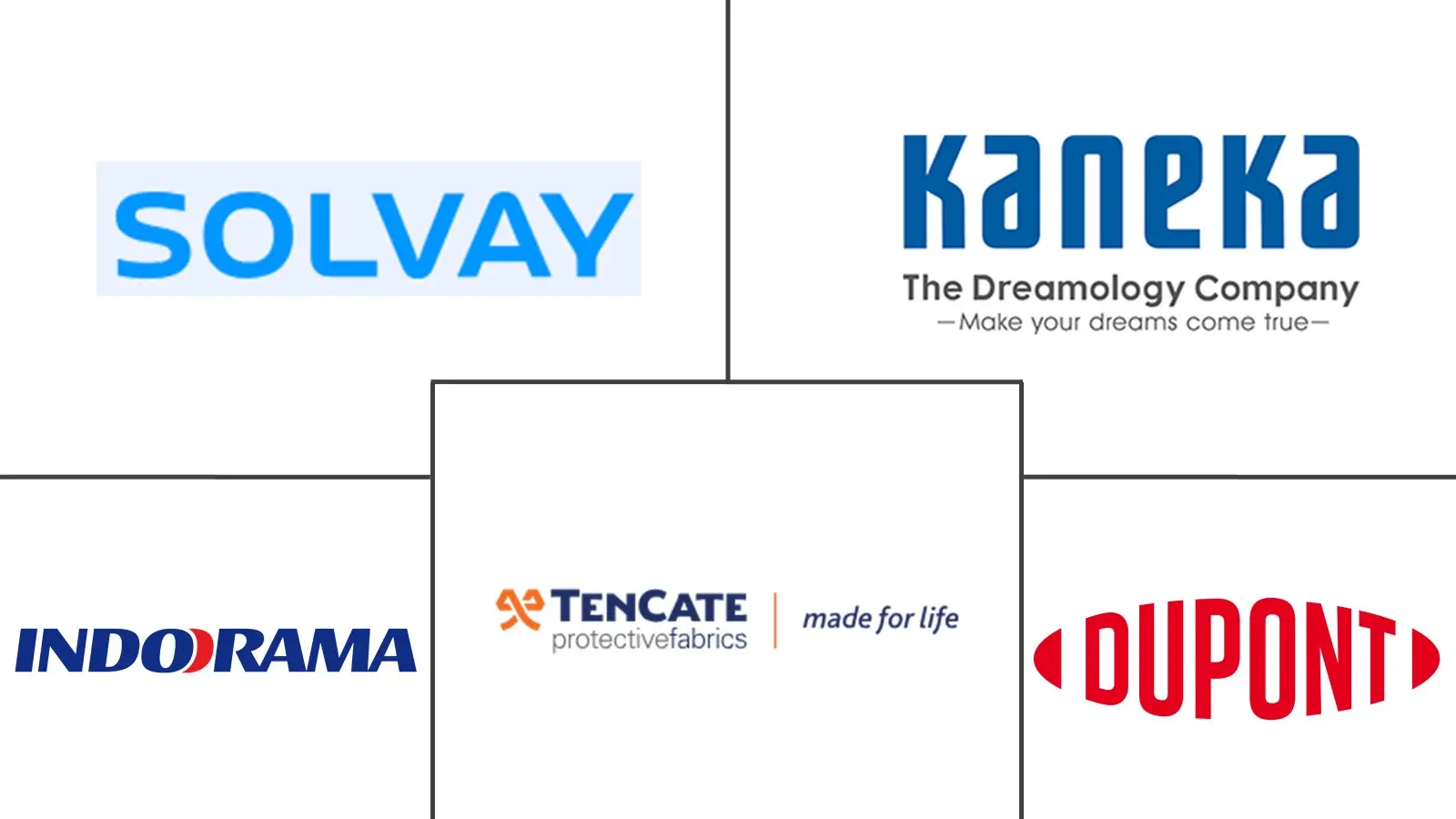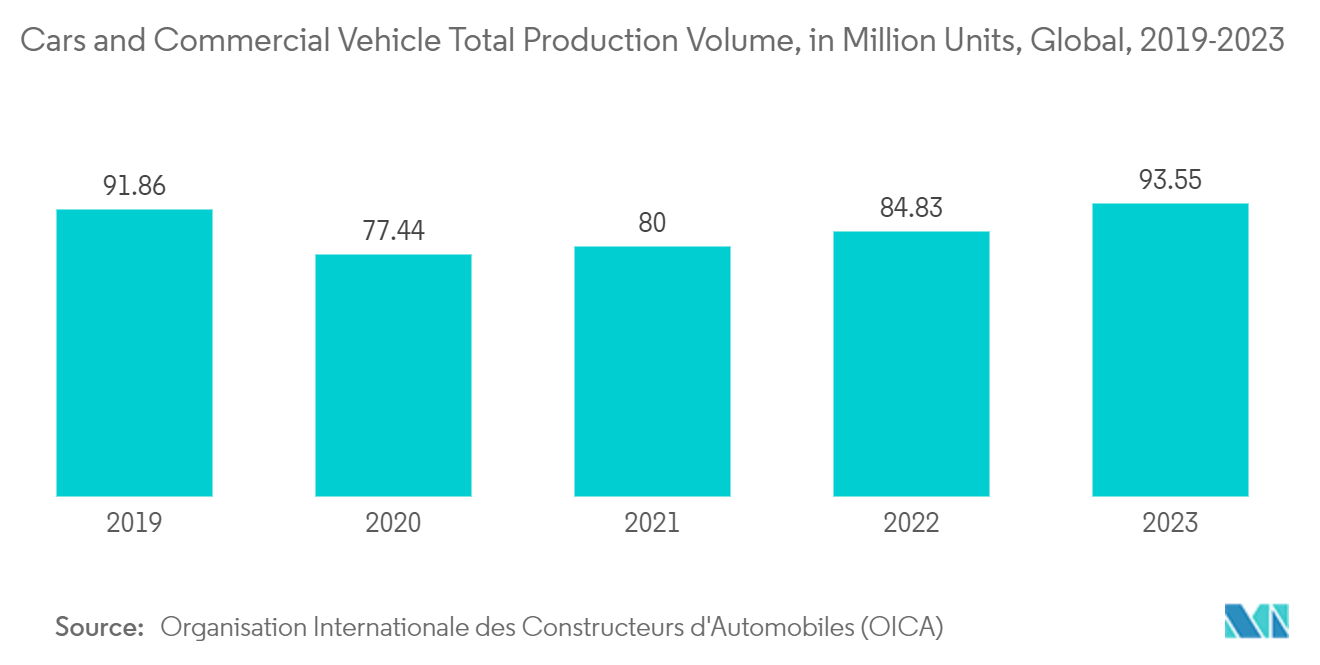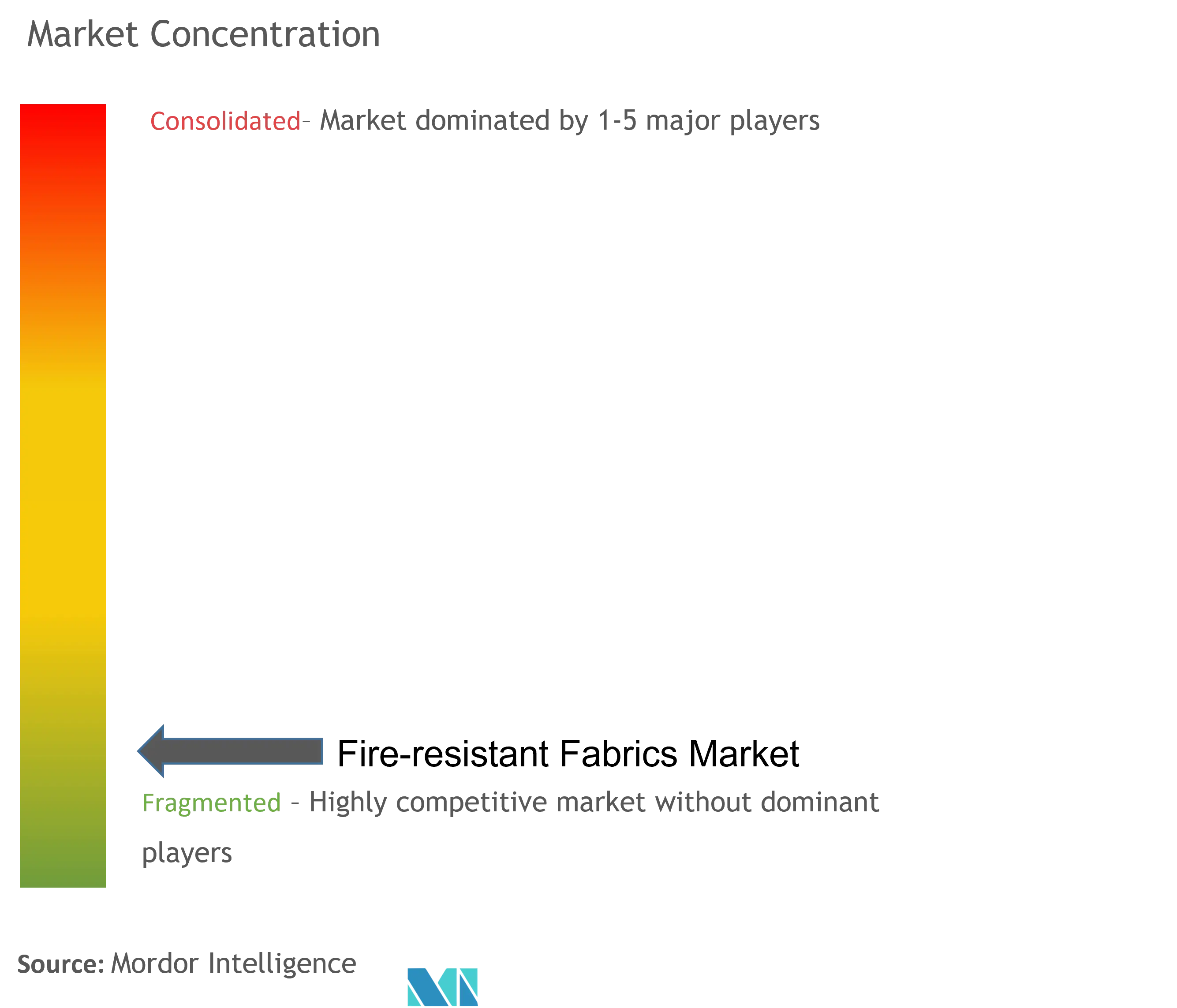Fire-resistant Fabrics Market Size

| Study Period | 2019 - 2029 |
| Market Size (2024) | USD 3.32 Billion |
| Market Size (2029) | USD 4.39 Billion |
| CAGR (2024 - 2029) | 5.73 % |
| Fastest Growing Market | Asia Pacific |
| Largest Market | Asia Pacific |
Major Players
*Disclaimer: Major Players sorted in no particular order |
Fire-resistant Fabrics Market Analysis
The Fire-resistant Fabrics Market size is estimated at USD 3.32 billion in 2024, and is expected to reach USD 4.39 billion by 2029, growing at a CAGR of 5.73% during the forecast period (2024-2029).
The market was negatively impacted due to the COVID-19 pandemic. Owing to the pandemic, several countries worldwide went into lockdown to curb the spread of the virus. This completely disrupted the supply and demand chain, negatively affecting the market. The market has recovered from the COVID-19 pandemic and has grown at a significant rate.
- Over the short term, stringent industrial standards for fabrics, the increasing demand for fire-resistant fabrics in home and commercial furnishing, and growing demand from the mining industry in South America are driving the market's growth.
- On the flip side, the high price of raw materials that are used to make fire-resistant fabric and the lack of safety compliances are expected to hinder the market's growth.
- Nevertheless, rapid industrialization in BRICS countries (Brazil, Russia, India, China, and South Africa) is expected to be an opportunity during the forecast period.
- Asia-Pacific is expected to account for the largest share during the forecast period, owing to increasing consumption from countries such as China and India.
Fire-resistant Fabrics Market Trends
Transport Segment to Dominate the Market
- Fire-resistant fabrics are used in the transport industry during railways, automotive, aircraft, and marine construction. The global transport sector is expected to grow healthy in response to foreign investments in constructing better railways, metro, and rail networks.
- According to the Organisation Internationale des Constructeurs d'Automobiles (OICA), the global automobile industry witnessed an increase in the production of cars and commercial vehicles, reaching 84.84 million units in 2022 and 93.55 million units in 2023. This, in turn, increased the demand for fire-resistant fabrics from this sector in 2022 and 2023.
- The car sales for 2022 in major global markets of the United States, Brazil, India, and China were up by 10%, 5%, 24%, and 3%, respectively, compared to the previous year.
- However, the development of electric vehicles is expected to continue to gain momentum in the future, especially in Europe and China, owing to government programs promoting the shift away from fossil fuels due to various environmental concerns, where designers in all the automotive segments are discovering new possibilities.
- In the automotive sector, the growing demand for electric vehicles in Asia-Pacific countries, like India, has also fueled the market's growth.
- According to the IEA (International Energy Association), in 2030, global electric vehicle sales are expected to reach 125 million as per the New Policies Scenario (excluding two/three-wheelers). In the EV30@30 Scenario, in 2030, in China, around 70% of vehicle sales are expected to be EVs. Half of the vehicles sold in Europe are EVs, with 37% in Japan, 29% in India, and 30% in Canada and the United States.
- Growing railway construction worldwide is expected to drive the demand for fire-resistant fabrics. The Indian government plans to develop metro rail projects in more than 30 Indian cities.
- The aviation industry is another popular mode of transportation that has been growing notably. It is known to be the fastest means of commuting to distant places. Selecting the right fabric material in aircraft production is as important as any other component. A substantial percentage of aircraft accident deaths are caused by fire and smoke inhalation and asphyxiation from toxic gases released during a fire.
- The growing passenger volumes and increasing aircraft retirements are expected to drive the need for new jets over the next two decades. According to Boeing Commercial Market Outlook 2023-2042, 42,000 new aircraft are expected to be delivered during 2023-2042.
- According to Boeing, the market value for commercial aircraft is expected to reach USD 3.1 trillion by 2028, as operators are expected to replace older jets with more fuel-efficient models and expand their fleets to cater to the steady rise in air travel in emerging and established markets. Hence, with the production of new jets, the demand for fire-resistant fabrics from the aerospace industry is also expected to increase during the forecast period.
- All the factors above are expected to drive the fire-resistant fabrics market during the forecast period.

China to Dominate the Asia-Pacific Market
- The growing manufacturing activities of the aerospace industry in the country mainly drive the demand for fire-resistant fabrics in China.
- This growth primarily depends on the rising passenger traffic due to the high consumer spending power and better air connectivity. The increasing passenger traffic is further creating a robust demand for aircraft.
- The Chinese aerospace policy represents one of the most comprehensive attempts to enter the top aerospace development and production levels. China is expected to be the world's largest single-country market for civil aircraft sales in the next 20 years. Under the plan 'Made in China 2025,' it is expected that China will supply over 10% of homemade commercial aircraft to the domestic market by 2025. This is expected to provide opportunities for the fire-resistant fabrics market in the aerospace sector during the forecast period.
- The automotive industry is one of the major consumers of fire-resistant fabrics. China is the leading producer of vehicles, with a total production volume of over 27 million vehicles in 2022, registering a growth rate of about 3% compared to the previous year, thus positively impacting the market demand for fire-resistant fabrics.
- Moreover, the government's focus on producing electric vehicles is expected to drive the demand for the fire-resistant fabrics market during the forecast period.
- The Chinese government plans to have at least 5,000 fuel-cell electric vehicles by 2025 and 1 million by 2030. The government’s promotion of electric, hybrid, and fuel-cell electric vehicles is expected to drive the market studied during the forecast period.
- All the abovementioned factors are expected to drive the demand for fire-resistant fabrics in the country over the forecast period.

Fire-resistant Fabrics Industry Overview
The fire-resistant fabrics market is fragmented in nature. The major companies (not in any particular order) include DuPont, Indorama Corporation, Solvay, KANEKA CORPORATION, and TenCate Protective Fabrics.
Fire-resistant Fabrics Market Leaders
-
Solvay
-
KANEKA CORPORATION
-
Indorama Corporation
-
DuPont
-
TenCate Protective Fabrics
*Disclaimer: Major Players sorted in no particular order

Fire-resistant Fabrics Market News
- August 2023: Newtex Industries, Inc. announced its successful acquisition of the Industrial Textile Division of Gentex Corp to make a significant expansion of Newtex's existing product portfolio. This acquisition includes the Dual-Mirror and FlexIR brands of aluminized fabrics.
- May 2023: TenCate Protective Fabrics introduced an inherently flame-resistant stretch fabric with the brand name Tecasafe 360+ to markets throughout the Americas, Europe, and Asia-Pacific.
- January 2023: Trevira GmbH was renamed Indorama Ventures Fibers Germany GmbH. Indorama Ventures is consolidating the names of all its associated companies under the corporate umbrella brand, Indorama Ventures, to provide a consistent brand experience for all stakeholders.
- June 2022: DuPont introduced a novel flame-resistant (FR) fabric with a bio-based chemical-repellent coating that increases the sustainability of protective apparel and improves worker safety. DuPont Nomex Comfort with EcoForce technology provides best-in-class flame and chemical resistance while addressing rising environmental concerns regarding personal protective equipment (PPE).
- June 2022: Ultrafabrics collaborated with Tapis Corporation and Franklin Products to develop Atago, a revolutionary fire-retardant fabric solution incorporating a state-of-the-art fire-blocking backcloth.
Fire-resistant Fabrics Market Report - Table of Contents
1. INTRODUCTION
- 1.1 Study Assumptions
- 1.2 Scope of the Study
2. RESEARCH METHODOLOGY
3. EXECUTIVE SUMMARY
4. MARKET DYNAMICS
-
4.1 Drivers
- 4.1.1 Stringent Industrial Standards for Fabrics
- 4.1.2 Increasing Demand for Fire-resistant Fabrics in Home and Commercial Furnishing
- 4.1.3 Growing Demand from the Mining Industry in South America
-
4.2 Restraints
- 4.2.1 High Price of Raw Materials Used to Make Fire-resistant Fabrics
- 4.2.2 Lack of Safety Compliance
- 4.3 Industry Value Chain Analysis
-
4.4 Porter's Five Forces Analysis
- 4.4.1 Bargaining Power of Suppliers
- 4.4.2 Bargaining Power of Buyers
- 4.4.3 Threat of New Entrants
- 4.4.4 Threat of Substitute Products and Services
- 4.4.5 Degree of Competition
5. MARKET SEGMENTATION (Market Size in Value)
-
5.1 By Type
- 5.1.1 Apparel
- 5.1.2 Non-apparel
-
5.2 By Application
- 5.2.1 Industrial Protective and Mining Clothing
- 5.2.2 Transport
- 5.2.2.1 Railway
- 5.2.2.2 Aircraft
- 5.2.2.3 Automotive (Roadway)
- 5.2.2.4 Marine
- 5.2.3 Defense and Firefighting Service
- 5.2.4 Other Applications
-
5.3 By Geography
- 5.3.1 Asia-Pacific
- 5.3.1.1 China
- 5.3.1.2 India
- 5.3.1.3 Japan
- 5.3.1.4 South Korea
- 5.3.1.5 Thailand
- 5.3.1.6 Malaysia
- 5.3.1.7 Indonesia
- 5.3.1.8 Vietnam
- 5.3.1.9 Rest of Asia-Pacific
- 5.3.2 North America
- 5.3.2.1 United States
- 5.3.2.2 Canada
- 5.3.2.3 Mexico
- 5.3.3 Europe
- 5.3.3.1 Germany
- 5.3.3.2 United Kingdom
- 5.3.3.3 Italy
- 5.3.3.4 France
- 5.3.3.5 Spain
- 5.3.3.6 Russia
- 5.3.3.7 NORDIC
- 5.3.3.8 Turkey
- 5.3.3.9 Rest of Europe
- 5.3.4 South America
- 5.3.4.1 Brazil
- 5.3.4.2 Argentina
- 5.3.4.3 Colombia
- 5.3.4.4 Rest of South America
- 5.3.5 Middle East and Africa
- 5.3.5.1 Saudi Arabia
- 5.3.5.2 South Africa
- 5.3.5.3 Qatar
- 5.3.5.4 United Arab Emirates
- 5.3.5.5 Egypt
- 5.3.5.6 Nigeria
- 5.3.5.7 Rest of Middle East and Africa
6. COMPETITIVE LANDSCAPE
- 6.1 Mergers and Acquisitions, Joint Ventures, Collaborations, and Agreements
- 6.2 Market Share (%) **/Ranking Analysis
- 6.3 Strategies Adopted by Leading Players
-
6.4 Company Profiles
- 6.4.1 DuPont
- 6.4.2 Glen Raven Inc.
- 6.4.3 Indorama Corporation
- 6.4.4 KANEKA CORPORATION
- 6.4.5 LENZING AG
- 6.4.6 Newtex Industries Inc.
- 6.4.7 PBI Fibers International
- 6.4.8 Solvay
- 6.4.9 Teijin Carbon Europe GmbH
- 6.4.10 TenCate Protective Fabrics
- 6.4.11 W. L. Gore & Associates Inc.
- 6.4.12 Westex: A Milliken Brand
- *List Not Exhaustive
7. MARKET OPPORTUNITIES AND FUTURE TRENDS
- 7.1 Rapid Industrialization in BRICS Countries
- 7.2 Other Opportunities
Fire-resistant Fabrics Industry Segmentation
Fire-resistant fabrics are textiles designed to provide superior resistance to fire compared to traditional materials, using fireproof fibers or chemical treatment. The fiber swells and becomes thicker when exposed to flame, forming a protective barrier between the fire source and the skin.
The fire-resistant fabrics market is segmented by type, application, and geography. By type, the market is segmented into apparel and non-apparel. By application, the market is segmented into industrial protective and mining, clothing, transport, defense, and firefighting services, and other applications (parachute fabric, motor racing apparel, etc.). The report also offers market size and forecasts for 27 countries across major regions. For each segment, market sizing and forecasts were done on the basis of value (USD).
| By Type | Apparel | |
| Non-apparel | ||
| By Application | Industrial Protective and Mining Clothing | |
| Transport | Railway | |
| Aircraft | ||
| Automotive (Roadway) | ||
| Marine | ||
| Defense and Firefighting Service | ||
| Other Applications | ||
| By Geography | Asia-Pacific | China |
| India | ||
| Japan | ||
| South Korea | ||
| Thailand | ||
| Malaysia | ||
| Indonesia | ||
| Vietnam | ||
| Rest of Asia-Pacific | ||
| By Geography | North America | United States |
| Canada | ||
| Mexico | ||
| By Geography | Europe | Germany |
| United Kingdom | ||
| Italy | ||
| France | ||
| Spain | ||
| Russia | ||
| NORDIC | ||
| Turkey | ||
| Rest of Europe | ||
| By Geography | South America | Brazil |
| Argentina | ||
| Colombia | ||
| Rest of South America | ||
| By Geography | Middle East and Africa | Saudi Arabia |
| South Africa | ||
| Qatar | ||
| United Arab Emirates | ||
| Egypt | ||
| Nigeria | ||
| Rest of Middle East and Africa |
Fire-resistant Fabrics Market Research FAQs
How big is the Fire-resistant Fabrics Market?
The Fire-resistant Fabrics Market size is expected to reach USD 3.32 billion in 2024 and grow at a CAGR of 5.73% to reach USD 4.39 billion by 2029.
What is the current Fire-resistant Fabrics Market size?
In 2024, the Fire-resistant Fabrics Market size is expected to reach USD 3.32 billion.
Who are the key players in Fire-resistant Fabrics Market?
Solvay, KANEKA CORPORATION, Indorama Corporation, DuPont and TenCate Protective Fabrics are the major companies operating in the Fire-resistant Fabrics Market.
Which is the fastest growing region in Fire-resistant Fabrics Market?
Asia Pacific is estimated to grow at the highest CAGR over the forecast period (2024-2029).
Which region has the biggest share in Fire-resistant Fabrics Market?
In 2024, the Asia Pacific accounts for the largest market share in Fire-resistant Fabrics Market.
What years does this Fire-resistant Fabrics Market cover, and what was the market size in 2023?
In 2023, the Fire-resistant Fabrics Market size was estimated at USD 3.13 billion. The report covers the Fire-resistant Fabrics Market historical market size for years: 2019, 2020, 2021, 2022 and 2023. The report also forecasts the Fire-resistant Fabrics Market size for years: 2024, 2025, 2026, 2027, 2028 and 2029.
Fire-resistant Fabrics Industry Report
Statistics for the 2024 Fire-resistant Fabrics market share, size and revenue growth rate, created by Mordor Intelligence™ Industry Reports. Fire-resistant Fabrics analysis includes a market forecast outlook to 2029 and historical overview. Get a sample of this industry analysis as a free report PDF download.



